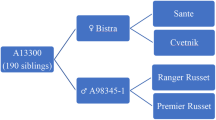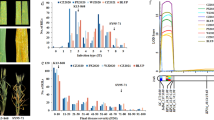Abstract
Cotton (Gossypium spp.) is the most widely-grown natural fiber crop used by the textile industry. Fusarium wilt, caused by Fusarium oxysporum f. sp. vasinfectum (FOV) comprised of eight nominal pathogenic races, is one of the most destructive diseases in cotton. FOV race 4 (FOV4) is an emerging threat to cotton production in the US. In this study, a total of 3258 lines including 3080 Upland (G. hirsutum) and 178 Pima (G. barbadense) germplasm lines were evaluated in 21 tests under greenhouse or temperature-controlled conditions for resistance to FOV4. A total of 2224 lines from 13 tests were screened in a commercial potting soil in the greenhouse under higher temperature (HT) conditions (24–32 °C), while 1204 lines from 8 tests were screened in a naturally FOV4-infected farm soil at a lower temperature (LT) setting (20–21 °C), both with artificial inoculations. The 170 Pima lines were evaluated in both temperature regimes. The results showed that, at 30 days post inoculation, both temperature regimes produced similar disease incidence (81.2% for HT vs. 86.8% for LT), but LT caused significantly higher disease severity ratings (DSR, 3.86 vs. 1.94) and plant mortality (81.7% vs. 7.5%) than did HT. DSR and morality rate were highly significantly correlated (r = 0.849–0.941) at LT. Significant genotypic variations in DSR were detected in all studies except two, and the broad-sense heritability estimates for DSR were 0.59–0.83 with an average of 0.70 at HT and 0.61–0.72 with an average of 0.69 at LT, indicating that 70% the phenotypic variation in FOV4 resistance was determined by genetic variation. Using the naturally FOV4-infected farm soil and LT to screen 1034 Upland and 170 Pima germplasm lines (with 20–40 plants for each line) with artificial inoculations, 48% showed 100% mortality; 22% had a mortality rate between 70 and 99%; 5% had mortality below 30%; and 0.5% (6 lines) did not display any apparent FOV4 symptoms. The results indicated that many existing available germplasm lines may be heterogeneous for FOV4 resistance and pedigree selection within germplasm may increase frequencies of resistant plants. This study represents one of the first publicly reported large-scale screenings of cotton for FOV4 resistance in the US and provides useful information for breeding cotton with resistance to FOV4.


Similar content being viewed by others
References
Armstrong GM, Armstrong JK (1960) American, Egyptian, and Indian cotton-wilt Fusaria: Their pathogenicity and relationship to other wilt fusaria. US Dep Agric Tech Bull 1219:1–19
Chen ZS (1980) Evaluation of cotton germplasm resources resistant to verticillium wilt in the field. China Cottons 3:25–28
Cianchetta AN, Allen TW, Hutmacher RB, Kemerait RC, Kirkpatrick TC, Lawrence GW, Lawrence KS, Mueller JD, Nichols RL, Olsen MW, Overstreet C, Woodward JE, Davis RM (2015) Survey of Fusarium oxysporum f. sp. vasinfectum in the United States. J Cotton Sci 19:328–336
Dyer DR, Lawrence K, Aida M (2019) Evaluation of the temporal and spatial occurrence of Fusarium oxysporum f. sp. vasinfectum races as influenced by selected cotton genotypes in the National Cotton Fusarium Wilt Evaluation field in Alabama. Proceedings of the Beltwide Cotton Conference p. 364–371
Feaster CV, Turcotte EL (1984) Registration of ‘Pima S-6’ cotton. Crop Sci 24:382
Feng CD, Zhang JF, Liu J, Sun J (1996) Inheritance of resistance to Fusarium wilt in several Chinese upland cotton varieties. Acta Agron Sin 22:550–554
Feng CD, Zhang JF, Liu J, Wu Z, Guo J, Sun JZ (1998) Allelism and linkage test of upland cotton genes resistant to Fusarium wilt. Hereditas 20(1):33–36
Glass KM, Lawrence L, van Santen E (2013) National cotton Fusarium wilt report. Agron. and Soil Dep. Ser. no. 332 Alabama Ag Exp St, Auburn University, Alabama, p. 13
Halpern HC, Bell AA, Wagner TA, Liu J, Nichols RL, Olvey J, Woodward JE, Sanogo S, Jones CA, Chan CT, Brewer MT (2018) First report of Fusarium wilt of cotton caused by Fusarium oxysporum f. sp. vasinfectum race 4 in Texas, USA. Plant Dis 102:446
Hillock RJ (1992) Fusarium wilt. In: Hillocks RJ (ed) Cotton diseases. CAB International, Wallingford, pp 127–160
Holmes EA, Bennett RS, Spurgeon DW, Colyer PD, Davis RM (2009) New genotypes of Fusarium oxysporum f. sp. vasinfectum from the southeastern United States. Plant Dis 93:1298–1304
Hutmacher RB, Ulloa M, Wright SD, Davis RM, Keeley MP, Delgado R, Banuelos R, Marsh G, Monk DS (2011) Fusarium race 4: Management recommendations for growers. Proceedings of the Beltwide Cotton Conference, p. 188–192
Hutmacher RB, Ulloa M, Wright SD, Campbell BT, Percy R, Wallace T, Myers G, Bourland F, Weaver D, Chee P, Thaxton P, Zhang JF, Smith W, Dever J, Kuraprthy V, Bowman D, Jones D, Burke J (2013) Assessment of elite Upland cotton germplasm pool for Fusarium wilt (FOV) resistance in California. Agron J 105:1632–1644
Kappelman AJ (1971) Fusarium wilt resistance in commercial cotton varieties. Plant Dis Rep 55:896–899
Kappelman AJ (1975) Fusarium wilt resistance in cotton (Gossypium hirsutum). Plant Dis Rep 59:803–805
Kappelman AJ (1980) Long-term progress made by cotton breeders in developing Fusarium wilt resistant germplasm. Crop Sci 20:613–615
Kappelman AJ (1981) Fusarium wilt resistance of two cotton cultivars from Paraguay. Plant Dis Rep 65:344–345
Kappelman AJ (1982) Resistance to Fusarium wilt pathogen in currently used cotton cultivars. Plant Dis 66:837–839
Kim Y, Hutmacher RB, Davis RM (2005) Characterization of California isolates of Fusarium oxysporum f. sp. vasinfectum. Plant Dis 89:366–372
Luo JL, Xia WS, Lu JD, Ji RZ, Wu YH (1980) Studies on Fusarium wilt resistance of the cultivar resources of cotton. Sci Agric Sin 3:41–46
Percy RG (1998) Registration of extra-long staple cotton germplasm, 89590 and 8810. Crop Sci 38:1407
Sanogo S, Zhang JF (2016) Resistance sources, resistance screening techniques and disease management for Fusarium wilt in cotton. Euphytica 207:255–271
Smith AL (2015) Identification of resistant or tolerant commercial cotton cultivars to the fusarium wilt root-knot nematode disease complex and the identification of Fusarium oxysporum f. sp. vasinfectum races in Alabama. M.S. thesis, Auburn Univ. 50 pp. Available at: https://etd.auburn.edu/bitstream/handle/10415/4563/Smith_Amber_MSThesis_Spring%25202015.pdf?sequence=2&isAllowed=y.
Sun WJ, Chen QY, Ma C, Shi LY, Jian GL (1990) Identification on cotton germplasms for resistance to Fusarium and Verticillium wilt. Sci Agric Sin 23:81–90
Ulloa M, Hutmacher RB, Davis RM, Bennett R, Percy R, Marsh B, Wright SD, McGuire M (2006a) Commercial and improved germplasm evaluations for Fusarium wilt, FOV race 1 with root-knot nematodes and race 4. Proceedings of the Beltwide Cotton Conference p. 883–893
Ulloa M, Hutmacher RB, Davis RM, Wright SD, Percy R, Marsh B (2006) Breeding for Fusarium wilt race 4 resistance in cotton under field and greenhouse conditions. J Cotton Sci 10:114–127
Ulloa M, Hutmacher RB, Roberts PA, Wright SD, Nichols RL, Davis RM (2013) Inheritance and QTL mapping of Fusarium wilt race 4 resistance in cotton. Theor Appl Genet 126:1405–1418
Ulloa M, Wang C, Saha S, Hutmacher RB, Stelly DM, Jenkins JN, Roberts P (2016) Analysis of root-knot nematode and fusarium wilt disease resistance in cotton (Gossypium spp.) using chromosome substitution lines from two alien species. Genetica 144:167–179
Woodward JE, Wheeler TA (2010) Screening cultivars for resistance to Fusarium wilt in west Texas. Proceedings of the Beltwide Cotton Conference, p. 295–301
Zhang JF (2018) Fighting Fusarium wilt through breeding in cotton: a successful story in China. Proceedings of the Beltwide Cotton Conference, p. 877–879
Zhang JF, Sanogo S, Flynn R, Baral JB, Bajaj S, Hughs SE, Percy RG (2012) Germplasm evaluation and transfer of Verticillium wilt resistance from Pima (Gossypium barbadense) to Upland cotton (G. hirsutum). Euphytica 187:147–160
Zhang JF, Percy RG, McCarty JC (2014) Introgression genetics and breeding between Upland and Pima cotton: A review. Euphytica 198:1–12
Zhang JF, Sanogo S, Ma ZY, Qu YY (2015) Breeding, genetics, and quantitative trait locus mapping for Fusarium wilt resistance in cotton. Crop Sci 55:2435–2453
Zhang JF, Idowu J, Flynn R, Hughs SE, Jones DC, Wedegaertner T (2016) Registration of glandless ‘NuMex COT 15 GLS’ cotton. J Plant Regist 10:223–227
Zhang JF, Idowu OJ, Wedegaertner T (2020) Registration of glandless ‘NuMex COT 17 GLS’ Upland cotton cultivar with Fusarium wilt race 4 resistance. J Plant Regist 14:1–9
Zhang JF, Zhu Y, Abdelraheem A, Lujan P, Idowu J, Nichols R, Wedegaertner T (2020) Field survey, detection and characterization of Fusarium wilt race 4 in cotton in New Mexico. Proceedings of the Beltwide Cotton Conference (in press)
Zhu Y, Abdelraheem A, Teng ZH, Sanogo S, Wheeler T, Wedegaertner T, Zhang JF (2019) Pathogenicity test of Fusarium wilt and screening germplasm lines for Fusarium wilt resistance in cotton. Proceedings of the Beltwide Cotton Conference, p.15
Zhu Y, Lujan PA, Wedegaertner T, Nichols R, Abdeiraheem, A, Zhang JF, Sanogo S (2020) First report of Fusarium oxysporum f. sp. vasinfectum race 4 causing Fusarium wilt of cotton in New Mexico, USA. Plant Dis 104:588
Author information
Authors and Affiliations
Corresponding author
Additional information
Publisher's Note
Springer Nature remains neutral with regard to jurisdictional claims in published maps and institutional affiliations.
Rights and permissions
About this article
Cite this article
Zhang, J., Abdelraheem, A., Zhu, Y. et al. Assessing genetic variation for Fusarium wilt race 4 resistance in tetraploid cotton by screening over three thousand germplasm lines under greenhouse or controlled conditions. Euphytica 216, 108 (2020). https://doi.org/10.1007/s10681-020-02646-2
Received:
Accepted:
Published:
DOI: https://doi.org/10.1007/s10681-020-02646-2




